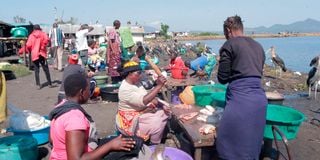A captivating tour of Homa Bay, the gateway to Lake Victoria

Women scaling and dissecting fish at Kogina beach in Homa Bay town on September 18, 2022. Agriculture, livestock and fisheries are by far the largest sector in Homa Bay county, accounting for Sh54 billion or 44 per cent of economic activity.
What you need to know:
- Agriculture, livestock and fisheries are by far the largest sector, accounting for Sh54 billion or 44 per cent of economic activity.
- Farmers grow sugarcane, pawpaw, mangoes and other fruits. The county agriculture department estimates the herd size at 160,000, of which 80 per cent are indigenous zebus.
- This border county is bristling with renewed energy and expectation. There is a new boss in town; H.E. Gladys Wanga.
I was in Homa Bay County this week. Unlike a couple of past visits that lasted a few hours, I spent several days and visited Mfangano and Rusinga islands for the first time.
Quietly and without fanfare, I visited the Tom Mboya mausoleum and had tea at the famous Rusinga Lodge.
What a pleasant experience! The citizens I met were warm, and outgoing, with an easy laugh and vibrant energy.
Being from landlocked Laikipia, I found the immensity of the lake breathtaking. Reluctantly, I had to concede the sundowners rival those on the Laikipia plains.
Homa Bay’s economy is Sh122 billion annually. According to the Kenya National Bureau of Statistics’ county gross product report 2021, the county is number 25 out of 47 counties by economic size and has a population of 1.13 million Kenyans.
The latest – but now quite old – census of micro, small and medium enterprises found 48,000 licensed and 134,000 unlicensed MSMEs in Homa Bay in 2016. We can expect that these numbers have really grown.
What a gem! We marvelled as we drove and sailed around the county’s 146 beaches.
About 58 per cent of the land mass has a shoreline, it was explained to us. It wasn’t long before one of my colleagues voiced what has become a craze in our neck of the words – where could we find plot maguta, maguta?
Economy
Agriculture, livestock and fisheries are by far the largest sector, accounting for Sh54 billion or 44 per cent of economic activity.
Farmers grow sugarcane, pawpaw, mangoes and other fruits. The county agriculture department estimates the herd size at 160,000, of which 80 per cent are indigenous zebus.
For inland folk like me, the water bus at Mbita point is fascinating. But it is the thousands of fishing boards that I found most captivating.
Some have outboard motors, some don’t. County estimates indicate Homa Bay has about 6,500 such boats.
In the evening, when they are out fishing, they have lights on to attract omena. When you observe them in the distance, their formation resembles the lights of a city.
The Suba are bantus, Jack, our guide on day three, explains. The community first arrived in Mfangano from the direction of Uganda and spread to Rusinga and other islands.
There is rich rock art on Mfangano and a Suba cultural museum. Regrettably, time is too short and I make a mental note to explore it on my next trip.
This border county is bristling with renewed energy and expectation. There is a new boss in town; H.E. Gladys Wanga.
As I interact with traders in Mbita and later in Homa Bay town, it is clear she has enormous goodwill.
They tell me they are keen to resume paying taxes and would prefer cashless payments on mobile and other platforms.
As a former governor myself, that is music to my ears. Whistling, we head to lunch. The ugali and fish are to die for.
Many Kenyan towns are very similar. The National Cereals and Produce Board has a depot in Homa Bay.
Kenya Industrial Estates has an estate, although activity seems rather low. There are four mid-range hotels and many for the modest budget.
One thing is clear; we don’t travel nearly enough in our own country.
@NdirituMuriithi is an economist





